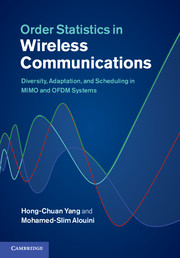 Order Statistics in Wireless Communications
Order Statistics in Wireless Communications Published online by Cambridge University Press: 07 October 2011
Introduction
Diversity combining can considerably improve the performance of wireless system operating over fading channels [1, 2]. In general, the performance gain increases as the number of diversity branches increases, although with a diminishing gain. These results have motivated the recent development of several wideband wireless systems, where a large number of diversity paths exist. Examples include wideband code division multiple access (WCDMA) systems [3], ultra wideband (UWB) systems [4], and millimeter (MM)-wave systems [5]. While huge diversity benefits can be explored in the resulting diversity-rich environment, it is critical to exploit those benefits efficiently [6]. In particular, MRC is well-known to be the optimal combining scheme in a noise-limited environment. However, applying MRC in such a diversity-rich environment will entail very high system complexity. Note that we need to implement a receiver chain for each resolvable diversity path. In addition, processing all the diversity paths will lead to very high processing power consumption.
In this chapter, we present several advanced combining schemes for diversityrich environments. The general principle of these schemes is to select a proper subset of good diversity paths among those available and then combine them in an optimal MRC fashion. Specifically, these schemes will determine the path subset using the best-selection process or thresholding, or a combination of both. As expected intuitively, different schemes will lead to different performance versus complexity trade-offs. Based on accurate mathematical analysis, sometimes with the help of the order statistics results from the previous chapter, we are able to obtain the exact statistics of the combiner output SNR with these schemes, which are then utilized to quantify the trade-off study between performance and complexity between them.
To save this book to your Kindle, first ensure no-reply@cambridge.org is added to your Approved Personal Document E-mail List under your Personal Document Settings on the Manage Your Content and Devices page of your Amazon account. Then enter the ‘name’ part of your Kindle email address below. Find out more about saving to your Kindle.
Note you can select to save to either the @free.kindle.com or @kindle.com variations. ‘@free.kindle.com’ emails are free but can only be saved to your device when it is connected to wi-fi. ‘@kindle.com’ emails can be delivered even when you are not connected to wi-fi, but note that service fees apply.
Find out more about the Kindle Personal Document Service.
To save content items to your account, please confirm that you agree to abide by our usage policies. If this is the first time you use this feature, you will be asked to authorise Cambridge Core to connect with your account. Find out more about saving content to Dropbox.
To save content items to your account, please confirm that you agree to abide by our usage policies. If this is the first time you use this feature, you will be asked to authorise Cambridge Core to connect with your account. Find out more about saving content to Google Drive.